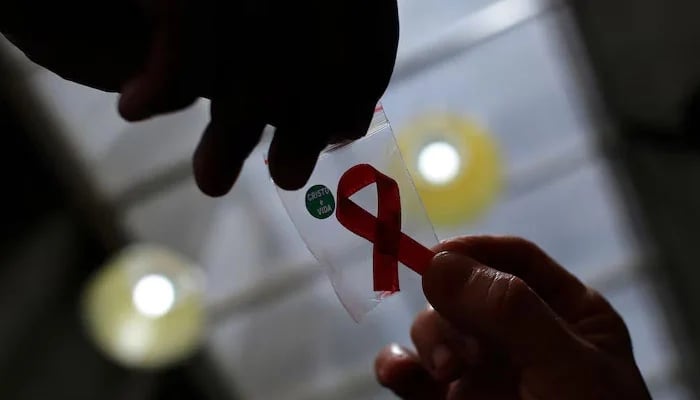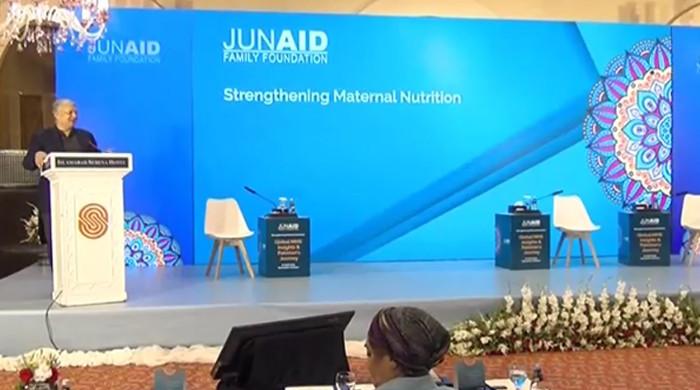Study reveals rising HIV prevalence in FSWs, TGs, MSM
MSM reports HIV prevalence of 7%, up from 5.6%, while prevalence among TGs has increased by 2.8% in 2016
January 23, 2025

- Study results shared with Ministry of National Health Services.
- Prevalence of HIV among PWID drastically decreased to 27%.
- There's urgent need to increase condom access, promote its use.
ISLAMABAD: Human immunodeficiency virus (HIV) has spread fast among specific populations including female sex workers (FSWs), men who have sex with men (MSM) and transgenders (TGs) due to unprotected sex and limited access to preventive measures.
A report presented at the Integrated Biological and Behavioural Surveillance (IBBS)’s sixth round showcased development and troubling trends in HIV outbreak in Pakistan, The News reported.
The initial results of the study were shared with the Ministry of National Health Services, Regulations, and Coordination on Tuesday. The study was carried out by the Health Services Academy (HSA) in partnership with the Progressive Development Initiative (PDI), UK, the HIV/STI Surveillance Research Center, and the WHO Collaborating Center for HIV Surveillance (HIVHUB), Iran, almost ten years after the last round.
The results present a mixed picture, showing the effectiveness of harm reduction programmes for People Who Inject Drugs (PWID) and the increasing prevalence of HIV in sexual networks, which act as a link between important groups and the general public.
While MSM reports HIV prevalence of 7%, up from 5.6% in the most recent survey, the prevalence among TGs has increased to 10%, up from 7.2% in 2016. The prevalence among FSWs has also increased, rising from 2.2% in 2016 to 3.8% at now. The prevalence of HIV among PWID, on the other hand, has drastically decreased from 38.4% in 2016 to 27%, thanks to harm reduction initiatives and a move toward non-injectable drug use, such as ice or methamphetamine.
The 4.7% HIV prevalence percentage among inmates—a population assessed for the first time in IBBS—is among the most alarming results. In correctional facilities, overcrowding, condom inaccessibility, and untreated drug use all contribute to the spread of HIV among this underserved demographic.
One of the largest surveys to date to measure HIV prevalence in Pakistan, IBBS Round 6 surveyed and tested 28,377 people, including 6,500 PWID, 7,606 MSM, 6,670 FSWs, 7,601 TGs, and 5,000 inmates.
The study was conducted across 31 districts, ensuring wide geographical representation, including Karachi, Lahore, Islamabad, Peshawar, Quetta, Faisalabad, Multan, Sukkur, Hyderabad, Jacobabad, Larkana, Rawalpindi, Gujranwala, and Gujrat.
The findings highlight significant barriers to condom use among TGs, MSM, and FSWs. While over 50% of TGs and MSM reported condom use, gaps in consistent use persist, particularly during high-risk encounters. Among FSWs, condom use remains at around 40%, hindered by limited availability of female condoms, client refusal, and stigma associated with carrying or requesting condoms.
These gaps underscore the urgent need for targeted interventions to increase condom access and promote their consistent use. Harm reduction efforts for PWID have demonstrated success, with increased availability of needle exchange programmes in both public and private sectors contributing to the decline in HIV prevalence within this group. However, challenges such as unsafe injecting practices, stigma, and substance abuse continue to pose risks.
The inclusion of prisoners as a vulnerable population in the IBBS for the first time has shed light on the vulnerabilities of incarcerated individuals.
The findings emphasise the urgent need for comprehensive HIV prevention, testing, and treatment services within correctional institutions.
The comparative analysis with 2016 data reflects a mixed outcome. While the declining prevalence among PWID signifies progress, the rising rates among TGs, MSM, and FSWs reveal serious gaps in prevention strategies. These gaps are further exacerbated by stigma, discrimination, and limited outreach efforts, which hinder access to care and protective measures for these populations.
The report also highlights educational disparities among key populations. A significant proportion of TGs, MSM, and FSWs lack secondary education, limiting their awareness of HIV prevention and protective measures. Among PWID, education levels are even lower, with many being completely illiterate. The survey also assessed prisoners, revealing that while some had completed primary or secondary education, many lacked comprehensive knowledge about HIV prevention.
The IBBS study also evaluated other vulnerable populations, such as truck drivers, migrant workers, and street children, whose high mobility, low condom use, and limited outreach make them particularly vulnerable to HIV. These groups require focused interventions to address their specific risk factors.
The study also highlights a critical oversight: the lack of focus on HIV transmission through weak infection prevention and control measures in healthcare settings.
Previous outbreaks, such as the devastating Rato Dero outbreak of 2019, underline the role of unsafe medical practices in spreading the virus. Future HIV prevention strategies must incorporate robust infection control protocols to mitigate these risks.











